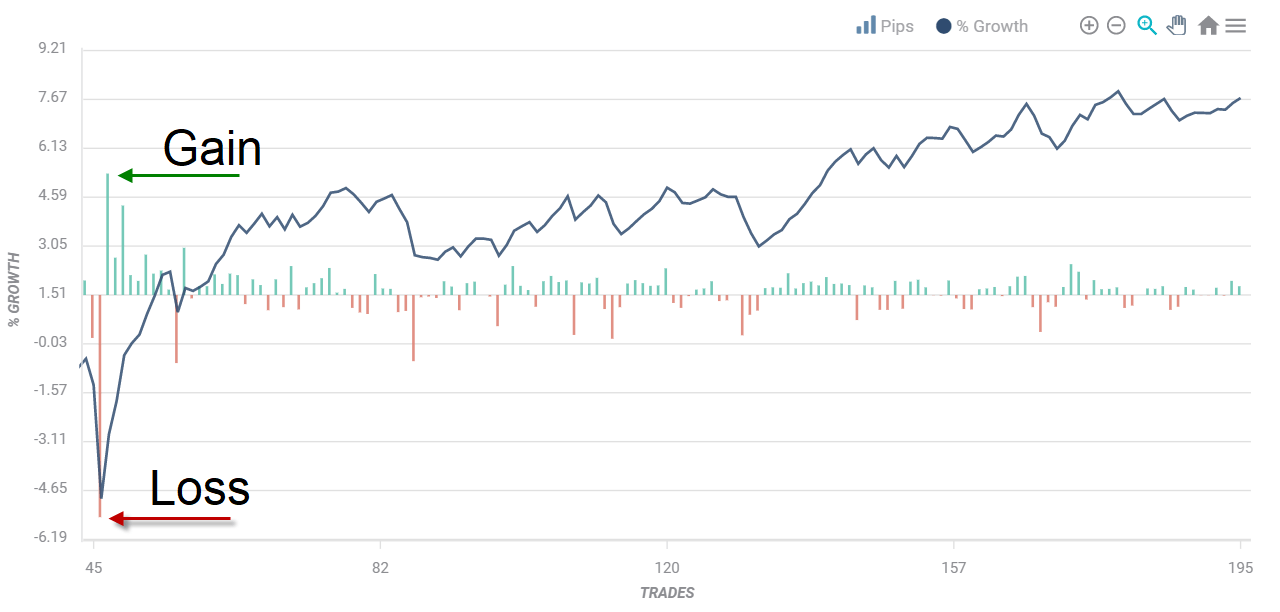Exits rules are part of the decision to take a trade. If the conditions for exiting positions are not fully defined when entering the trade, the trader may hold a losing position for too long in the hope of seeing the market returning. Inversely, the trader may not close a winning position at a high probability target, risking the trade to turn into a loss.
There are two types of exits:
- A stop loss to get out of a bad trade.
- A profit target to realize profits when the market moves in your favor.
Exit rules can take the form of fixed stops or limits-set in advance at a certain price levels, or dynamic exits using trailing stops, stop and reverse techniques, or conditions given by technical indicators.
Here at FXStreet, we make use of different kinds of dynamic stop loss rules in our Signals service. Here are some examples:
- A fixed pip amount. This is done with the Market Impact strategy. This strategy ignites trades based on the mathematical deviation between the Actual and Consensus figures. It finds out what was the average pip amount a certain pair reacted to a specific economic indicator, and sets the stop loss and the take profit in a 1:1 symmetrical ratio. Our traders may contextualize the trade in a bigger technical or macro view in order to assess a better risk/reward relationship, and alter therefore stops and targets during the life of the trade.
- A trailing stop. These can be fixed amount trailing stops which are usually not taking into account what the market is doing, and dynamic trailing stops. Our strategy Breakout Fibo 1H for instance, trails the stop to break-even in when a certain condition is given: the 1-hour close price, has to hurdle the first pivot point S or R on the way to the target (the 161.8% Fibonacci extension of the previous daily range).
- A stop adjusted to volatility. The advantage of adapting exits to volatility is that systems react to the same technical pattern or set-up in different volatility regimes. During the sell-off in March 2020, our Spread Reversion 30M strategy reacted extremely well to the increased volatility regime of those weeks. As you can see from the below performance chart, an initial loss of an exceptional pip amount was immediately recovered by a gain in a similar pip amount. A system using a fixed pip or trailing stop technique would have not endured the volatility explosion this well.
- A time stop. This is useful to get out of a trade and free your capital if the market is choppy. We use this technique in the Breakout Fibo strategy as well, allowing a maximum time duration of 2 days in case the trade is in negative territory.
- A technical level dictated by an indicator, a combination of indicators or a dynamic price level identified on a price chart. Although this is the most difficult way to place stops, it's also the smartest when you are working with automation. Since we base our Signals service on automated strategies, this is the most used type of exit in our strategies.
Price-based indicators like moving averages and oscillators, change their positions during the life of a trade. This makes it impossible to know where and when the final exit price will be at the moment of the entry.
Take for instance the above mentioned Spread Reversion strategy. In order to exit a trade at a loss, it memorizes the Average True Range (set to 14 periods) at the moment of entry, multiplies it by a predetermined amount, and it exist the trade if the the distance between the actual price and the entry level is equal or higher than the ATR multiple. Each of the individual strategy-pair-timeframe combinations uses an optimized multiplier, which is usually 2 or 3.
This is how it looks like on a flow diagram:
The Relative Strength D strategy in turn, exits a trade when the initial entry condition is not given anymore. This strategy takes 28 currency pairs and measures their internal strength and momentum. Based on those two readings, the strategy then establishes a ranking of the strongest and weakest pairs and buys the top of the list and at the same time sells the pair(s) on the bottom. Should a pair fall from its top position or rise from the bottom, the strategy closes that trade either in profit or in loss.
Summarizing:
Exiting a trade is as important -if not more- than entering a trade. If all kinds of techniques are used to generate entry signals, why not use this same knowledge to build clever exits? Besides, dynamic stops have the advantage they are not known to the market and therefore not prone to be hit when market forces suck up liquidity at stop clusters.
Note: All information on this page is subject to change. The use of this website constitutes acceptance of our user agreement. Please read our privacy policy and legal disclaimer. Opinions expressed at FXstreet.com are those of the individual authors and do not necessarily represent the opinion of FXstreet.com or its management. Risk Disclosure: Trading foreign exchange on margin carries a high level of risk, and may not be suitable for all investors. The high degree of leverage can work against you as well as for you. Before deciding to invest in foreign exchange you should carefully consider your investment objectives, level of experience, and risk appetite. The possibility exists that you could sustain a loss of some or all of your initial investment and therefore you should not invest money that you cannot afford to lose. You should be aware of all the risks associated with foreign exchange trading, and seek advice from an independent financial advisor if you have any doubts.
Editors’ Picks

EUR/USD climbs toward 1.1800 on broad USD weakness
EUR/USD gathers bullish momentum and advances toward 1.1800 in the second half of the day on Tuesday. The US Dollar weakens and helps the pair stretch higher after the employment report showed that Nonfarm Payrolls declined by 105,000 in October before rising by 64,000 in November.

GBP/USD climbs to fresh two-month high above 1.3400
GBP/USD gains traction in the American session and trades at its highest level since mid-October above 1.3430. The British Pound benefits from upbeat PMI data, while the US Dollar struggles to find demand following the mixed employment figures and weaker-than-forecast PMI prints, allowing the pair to march north.

Gold extends its consolidative phase around $4,300
Gold trades in positive above $4,300 after spending the first half of the day under bearish pressure. XAU/USD capitalizes on renewed USD weakness after the jobs report showed that the Unemployment Rate climbed to 4.6% in November and the PMI data revealed a loss of growth momentum in the private sector in December.

US Retail Sales virtually unchanged at $732.6 billion in October
Retail Sales in the United States were virtually unchanged at $732.6 billion in October, the US Census Bureau reported on Tuesday. This print followed the 0.1% increase (revised from 0.3%) recorded in September and came in below the market expectation of +0.1%.

Ukraine-Russia in the spotlight once again
Since the start of the week, gold’s price has moved lower, but has yet to erase the gains made last week. In today’s report we intend to focus on the newest round of peace talks between Russia and Ukraine, whilst noting the release of the US Employment data later on day and end our report with an update in regards to the tensions brewing in Venezuela.
RECOMMENDED LESSONS
Making money in forex is easy if you know how the bankers trade!
I’m often mystified in my educational forex articles why so many traders struggle to make consistent money out of forex trading. The answer has more to do with what they don’t know than what they do know. After working in investment banks for 20 years many of which were as a Chief trader its second knowledge how to extract cash out of the market.
5 Forex News Events You Need To Know
In the fast moving world of currency markets where huge moves can seemingly come from nowhere, it is extremely important for new traders to learn about the various economic indicators and forex news events and releases that shape the markets. Indeed, quickly getting a handle on which data to look out for, what it means, and how to trade it can see new traders quickly become far more profitable and sets up the road to long term success.
Top 10 Chart Patterns Every Trader Should Know
Chart patterns are one of the most effective trading tools for a trader. They are pure price-action, and form on the basis of underlying buying and selling pressure. Chart patterns have a proven track-record, and traders use them to identify continuation or reversal signals, to open positions and identify price targets.
7 Ways to Avoid Forex Scams
The forex industry is recently seeing more and more scams. Here are 7 ways to avoid losing your money in such scams: Forex scams are becoming frequent. Michael Greenberg reports on luxurious expenses, including a submarine bought from the money taken from forex traders. Here’s another report of a forex fraud. So, how can we avoid falling in such forex scams?
What Are the 10 Fatal Mistakes Traders Make
Trading is exciting. Trading is hard. Trading is extremely hard. Some say that it takes more than 10,000 hours to master. Others believe that trading is the way to quick riches. They might be both wrong. What is important to know that no matter how experienced you are, mistakes will be part of the trading process.
The challenge: Timing the market and trader psychology
Successful trading often comes down to timing – entering and exiting trades at the right moments. Yet timing the market is notoriously difficult, largely because human psychology can derail even the best plans. Two powerful emotions in particular – fear and greed – tend to drive trading decisions off course.


